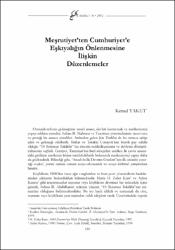| dc.contributor.author | Yakut, Kemal | |
| dc.date.accessioned | 2019-10-19T16:03:39Z | |
| dc.date.available | 2019-10-19T16:03:39Z | |
| dc.date.issued | 2012 | |
| dc.identifier.issn | 1300-2864 | |
| dc.identifier.uri | http://www.trdizin.gov.tr/publication/paper/detail/TVRRM05qTXdNQT09 | |
| dc.identifier.uri | https://hdl.handle.net/11421/14197 | |
| dc.description.abstract | Meşrutiyet'in 23 Temmuz 1908'de ikinci kez ilan edilmesi, sosyo-ekonomik ve sosyokültürel değişimin de habercisi oldu. Özellikle İttihat ve Terakki Cemiyeti'nin devletin merkezileşmesine yönelik ciddi adımlar atması, merkez-çevre gerilimini arttırdı. Bu bakış açısı öteden beri süregelen eşkıyalığın da önlenmesini gerektirdi. Taşra'da özel mülkiyet ilişkilerinin ve üretimin değişmeye başlaması, Makedonya kentlerinde dini ve etnik gerilimlerden beslenen çetelerin devletin otoritesini hiçe sayması gibi etkenler eşkıyalığın tasfiyesini kaçınılmaz kıldı. Hükümet, Eylül ve Ekim 1909'da önce Makedonya'daki çetelerin, ardından da Aydın Vilâyeti'ndeki eşkıya gruplarının ortadan kaldırılması için geçici kanunlar çıkarttı. Kanunların öngördüğü düzenlemeler çok sertti ve yer yer devlet şiddetine başvurulmasını içeriyordu. Meclis'te tartışmalara ve eleştirilere yol açtı. Cumhuriyet döneminde devlet otoritesini egemen kılmak ve toplumsal denetimi sağlamak üzere kanun çıkarılarak, eşkıyalık önlenmeye çalışıldı. | en_US |
| dc.description.abstract | The Second Constitutional era that started from the 23 July 1908 onwards represents a harbinger of socio-economic and socio-cultural changes. In particular, the steps taken by the Committee of Union and Progress (İttihat ve Terakki Cemiyeti) to consolidate the central state power resulted in an increase in the tension emerged between the centre and the periphery. It also aimed at the elimination of banditry that had long been an active phenomenon in the Ottoman lands. The new changes in the structure of private property and of production in the provinces and the formation of militia bands in the cities of Macedonia that were feeding on religious and ethnic tensions and ignoring the authority of the state necessitated to take certain measures to put an end to banditry. In September and October 1909, the government issued temporary laws, first for the elimination of bands in Macedonia and, second, for the elimination of groups of brigands in the province of Aydın. These were draconian laws that allowed the state to resort to violence as well. The laws were debated hotly and criticized in the Parliament. This article analyses such attempts to reinforce the state authority and control over the society not only in the late Ottoman history but also during the Republican Turkey through the introduction of similar laws to prevent banditry which still continued until the mid twentieth century. | en_US |
| dc.language.iso | tur | en_US |
| dc.rights | info:eu-repo/semantics/openAccess | en_US |
| dc.subject | Beşeri Bilimler | en_US |
| dc.subject | Ortak Disiplinler | en_US |
| dc.title | Meşrutiyet'ten Cumhuriyet'e eşkıyalığın önlenmesine ilişkin düzenlemeler | en_US |
| dc.title.alternative | Regulations for the prevention of banditry from the constitutional monarchy times to the republic | en_US |
| dc.type | article | en_US |
| dc.relation.journal | Kebikeç İnsan Bilimleri İçin Kaynak Araştırmaları Dergisi | en_US |
| dc.contributor.department | Anadolu Üniversitesi, Edebiyat Fakültesi, Tarih Bölümü | en_US |
| dc.identifier.volume | 0 | en_US |
| dc.identifier.issue | 34 | en_US |
| dc.identifier.startpage | 139 | en_US |
| dc.identifier.endpage | 158 | en_US |
| dc.relation.publicationcategory | Makale - Ulusal Hakemli Dergi - Kurum Öğretim Elemanı | en_US] |


















